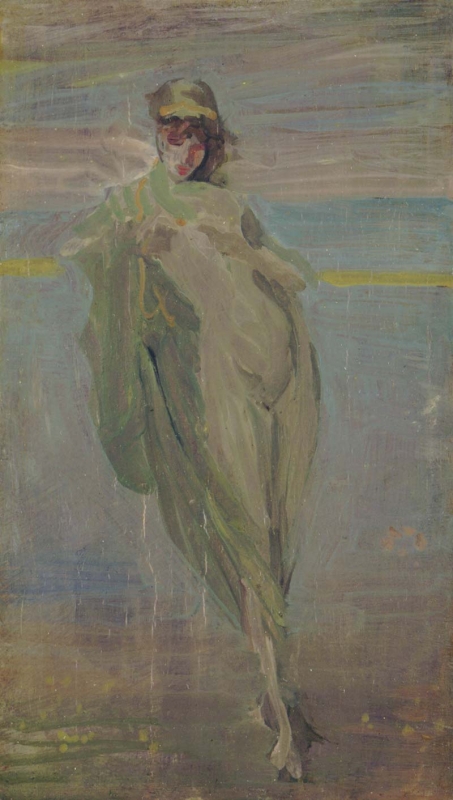Titles
Whistler's original title is not known. Only one title has been suggested:
- 'Ariel' (1905, Œuvres de James McNeill Whistler, Paris). 1
- 'Ariel' (1936, University of Glasgow). 2
- 'Ariel' (1980, YMSM). 3
It may be that the one known title 'Ariel' was mentioned by Whistler to his sister-in-law and executrix, Rosalind Birnie Philip (1873-1958) . If indeed the title dates back to Whistler's time, then it is one of only three literary titles given by Whistler to his paintings, the other two being Annabel Lee [YMSM 079] and Arrangement in Yellow and Grey: Effie Deans [YMSM 183]). In the case of Ariel, the title is derived from Shakespeare's play The Tempest.
Description
A small panel in vertical format, showing a slim young woman leaning back against a yellow railing in front of the sea. She leans very far to left, her right leg advancing in front of her left, in a dramatic but inherently unstable position. She wears a transparent gauze robe. A pale green cloak hangs behind her, clasped round her shoulders. She appears to be looking down, fastening the cloak over her chest. There is a dull green scarf around her head, tied with a yellow ribbon that falls down over her right side.
The foreground beach, dotted with pale yellow flowers or stones, merges imperceptibly into the sea, so that it looks more as if she is standing on a beach than a promenade or balcony, but the extreme position in which she stood could not be convincingly maintained without a railing.
Site
The composition does suggest the setting of Ariel's song in Act 1, Scene 2, of Shakespeare's The Tempest :
'Come unto these yellow sands, / And then take hands: / Courtsied when you have and kiss'd / The wild waves whist, / Foot it featly here and there; / And, sweet sprites, the burthen bear. / Hark, hark!'
Sitter
Whistler's model is unknown.
In Shakespeare's The Tempest, Ariel was an airy spirit imprisoned by the witch Sycorax in a cloven pine and released by the magic of Prospero, Duke of Milan, who employed Ariel to carry out his schemes. The cloak may be Prospero's magic cloak, rendering Ariel invisible.
Last updated: 22nd October 2020 by Margaret






